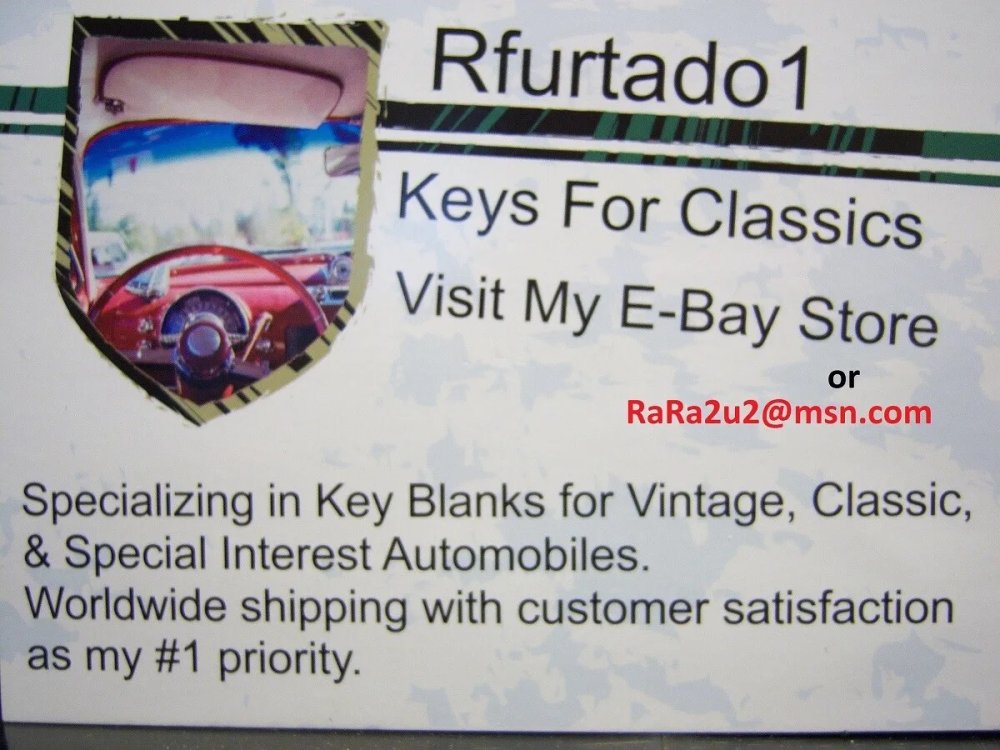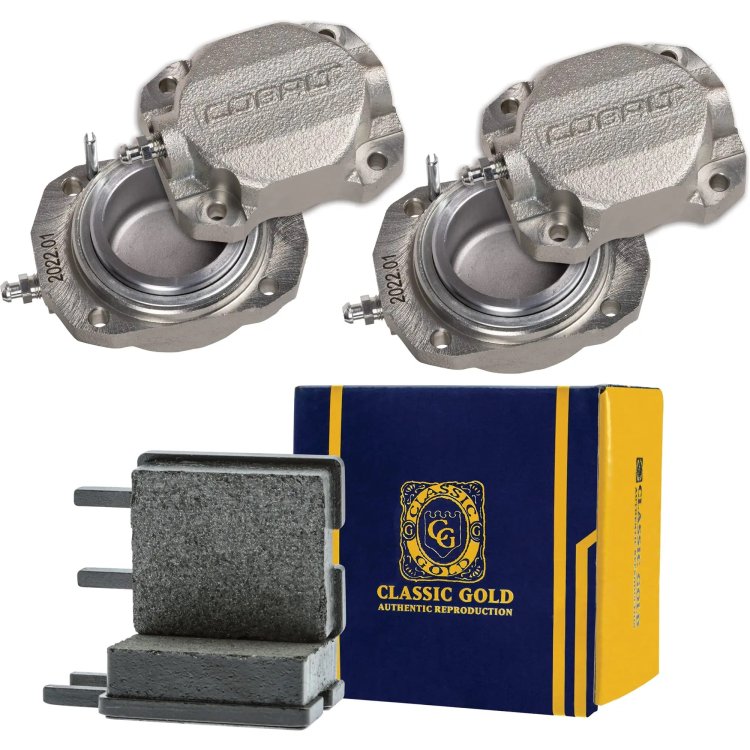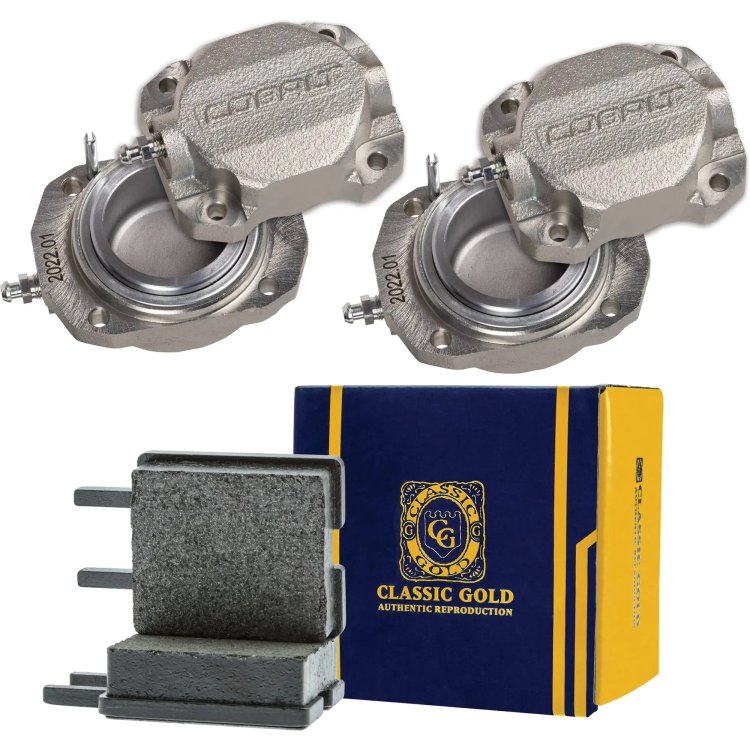
Dwight FitzSimons
-
Posts
447 -
Joined
-
Last visited
Content Type
Profiles
Forums
Events
Posts posted by Dwight FitzSimons
-
-
IIRC this late-1963 option for Avantis was called 813BKV (BKV = black vinyl). The list above states that 55 Avantis were so equipped. I guess that black was popular at the time. I would wish that Studebaker had chosen Elk for the solid-color option.
"1833 R2 'variants'" is just a poor way of stating that this car is one of 1833 1963-64 Avantis equipped with an R2 engine. I would have used different words, either "equipped with" or "R2 option."
That's a problem with BaT; they write the description, even though they're not experts on your particular make or model of car.
--Dwight
-
It seems to be hard today to find a local locksmith that has the old books needed to make keys from the manufacturer's codes. But, the attached company advertises that they can make keys from the key codes.
Whether R-4338 is worth saving would depend on several things:
1) Condition of frame & hog troughs, interior (especially the dash), engine &trans., etc. Ultimately, the feasibility of fixing it up would depend on the cost and availability of free labor (your own). I, personally, hate to see Studebaker Avantis parted out. But, R-4338 is well equipped for what we old Stude fans want today.
2) Availability of a title. In VA one can get a title for an untitled car. A local friend did just that for a '56 Power Hawk.
It would probably be a good idea to change the oil, then bring up oil pressure using a drill and a rod inserted in the distributor hole, before trying to start the engine.
--Dwight
-
Jon Myer in Ohio has a number of them.
--Dwight
-
15 hours ago, sailingadventure said:
I`ve been told that a Honda Civic battery will fit in your original battery support, but will be half as long. I haven`t tried it myself, but if you engine starts quickly with the other battery this may solve your problem. I`m still suffering along with the 7250 but I always keep a battery tender on it so they seem to last longer.
Great picture of a great engine compartment! Thanks, --Dwight
-
Has anyone tried two Honda Civic batteries placed end to end, and wired in parallel? (Although perhaps two won't fit.)
--Dwight
-
The traction bar mounts have been reproduced and can be welded on. Dave Thibeault in MA should still have them.
--Dwight
-
Do y'all know the formula for boost as a function of RPM, or can you point me to a source?
--Dwight
-
R3 & R4 rocker (valve) covers have two breather caps per cover. I assume the reason there are two is to evacuate the increased blowby gases that the R3/R4 engines produce due to their increased piston-to-cylinder-wall clearances. The larger clearances throughout the engine reduce frictional losses. (One result of this is that an R3 engine will rev up more quickly than an R2.)
Note that the diameter of the breather tubes on an R3 or R4 rocker cover is not the same as an R1 or R2 (or 259 or 289). It is larger, probably an eighth of an inch larger in diameter.
The larger "open" breather caps used on R3/R4 engines are also used on earlier six cylinder engines.
--Dwight
-
2 hours ago, Dwight FitzSimons said:
The Achilles heel of the original Bendix/Dunlop disc brakes is the very high line (hydraulic) pressure required to operate the disc brakes, so high that, without the boost from the booster, one cannot stop an Avanti. Think about that. This is due to the very small pads. Assuming that the coefficients of friction are equal a larger pad will provide more braking power than a smaller pad. That's why the Bendix/Dunlop cylinders must push in much harder to stop the car.
True (AFAIK), dual pistons will produce more even wear than a floating, single-piston, disc-brake system. IIRC, GM introduced 4-piston disc brakes in 1967, but switched to a single-floating-piston system in 1969, and stuck with that design for many years. That's the design that the Turner and Hot Rods & Brakes systems use. Those will easily stop a Studebaker without a booster.
The Cobalt cylinders use the same design as "modern" disc brake cylinders, although the pads are still the same small size. It would appear that the Cobalt cylinders will maintain their effectiveness much longer than the Bendix/Dunlop cylinders, so that is a plus for them.
--Dwight
P.S. Thanks to Rick Allen for doing such a good job of reporting the results of his Cobalt cylinders installation.
-
22 hours ago, Rick Allen said:
Many went to the Turner system which uses the aftermarket conversion brackets to mount the calipers and uses a single piston floating style caliper whereas the original Bendix/Dunlop system uses dual calipers for each wheel/pad as do the new Cobalt calipers, which promotes more even wear and braking power it is said.
The Achilles heel of the original Bendix/Dunlop disc brakes is the very high line (hydraulic) pressure required to operate the disc brakes, so high that, without the boost from the booster, one cannot stop an Avanti. Think about that. This is due to the very small pads. Assuming that the coefficients of friction are equal a larger pad will provide more braking power than a smaller pad. That's why the Bendix/Dunlop cylinders must push in much harder to stop the car.
True (AFAIK), dual pistons will produce more even wear than a floating, single-piston, disc-brake system. IIRC, GM introduced 4-piston disc brakes in 1967, but switched to a single-floating-piston system in 1969, and stuck with that design for many years. That's the design that the Turner and Hot Rods & Brakes systems use. Those will easily stop a Studebaker without a booster.
The Cobalt cylinders use the same design as "modern" disc brake cylinders, although the pads are still the same small size. It would appear that the Cobalt cylinders will maintain their effectiveness much longer than the Bendix/Dunlop cylinders, so that is a plus for them.
--Dwight
-
-
The car looks like a worthwhile project for someone with the skills and who is willing to put a lot of sweat equity into it. It looks to have a good frame and hog troughs and those are important positives. The dash looks good as does the rest of the interior. Changing to a more acceptable color interior would be possible and desirable.
I suspect that the body should be stripped to bare fiberglass because of the shoddy paint job. We don't know what is under the paint. Awful fiberglass repairs should be undone and redone properly. The engine needs to be fixed, along with the brakes, exhaust, suspension, (possibly) wiring harness, etc.
As to value my WAG is $5000 to $9000. Others on the Forum who buy & sell these things will have a better feel for the market value than I.
--Dwight
-
An Avanti has two "fuel" lines from the engine to the tank. One, the larger one, supplies fuel to the engine. The other one is a return line from the engine back to the tank. It returns fuel back to the tank in case of an over-pressure condition.
1963 & 1964 Avantis attach the return line to different places on the engine (63 at fuel pump, 64 at filter between fuel pump and carb).
The vent on top of the tank goes over to the passenger side of the vehicle, then down through the fiberglass and exits under the car. This one is a problem to replace.
--Dwight
-
One thought: I notice that the cylinders are fully exposed through the holes in my Halibrand wheels. And, someone has had the "Bendix" discs that were on early '63 Avantis reproduced. So, maybe one could glue those discs onto the Cobalt cylinders (after machining/sanding the "Cobalt" off). Just a thought for those who like their cars to look original.
--Dwight
-
4 hours ago, Nelson said:
Dwight. I agree, as much as I hate the sound of metal against metal it is a great warning sound that tells you it’s time to replace pads or shoes. The problem with the positive stop on the pads is you don’t realize your ability to make a panic stop does not exist when the pads are at the end of their life. I found that out the hard way and it was a good learning experience.
I was kidding about waiting for metal-on-metal noise before checking my brakes. I have always done my own brakes because they are so simple and so expensive.
I have, however, seen worse than even that. I once found a Pontiac in a junk yard whose pad material was long gone, AND with most of one side of the rotor gone. That is, the pad backing was rubbing on the ribs between the rotor plates. "Hey, Joe, what do you think that noise is?"
--Dwight
-
14 minutes ago, Nelson said:
Dwight. Back in the early 70’s John Shanahan told me about a machine/speed shop in South Bend that did a lot of work for Studebaker and that it had lots of performance parts still in stock. I made a point to stop there and check it out. Most of the parts were gone but I was able to buy the remainder (not many) of their R3/4 head gaskets. While there I noticed a lot of lose disc brake calipers on shelves and asked why so many. He said that Studebaker had, I assume, raw cores and they were boring them to different sizes as engineering was trying to balance the braking from front to rear. That made sense to me and considering how well the cars stopped back then I have to wonder if the additional 10% piston area is the right thing to do. I will say that a vacuum failure does make for a dangerous situation and I can sure see your concern. I will be interesting to see what difference these make with engine off braking.
Your concern with engine off braking certainly has plenty of merit. I wonder if a vacuum accumulator might be the best approach.
A larger piston area would have the effect of increasing the force on the rotor, and we can't get too much of that -- or am I missing something? Avantis don't get very much braking from the 11" non-self-energizing rear drum brakes, so there is little, if any, chance of locking up the rears in a panic stop. Locking up the rears is what we must fear because the rear of the car will swing around. I have had that happen on the '83 Pontiac Bonneville with front discs & self-energizing rear drum brakes that I used to drive (Thank you, GM!). (This is why Studebaker/Bendix used non-self-energizing rear drum brakes on the Avanti.)
Another thought: The thickness of the pads from Moss Motors assume a given rotor thickness. How thick are Jaguar rotors?
BTW, the metal pad backing hitting the rotor is how I have always known when to rebuild my car's brakes.
Any of the above is subject to correction by anyone more expert than I (which is just about everyone).
--Dwight
-
38 minutes ago, Zedman said:
Hi Rick- The pistons on your Cobalt cyls are hollow, whereas original Pistons are flat, wide and solid. Stock pads are quite small. Are these pistons going to properly bear on the small 'Bendix' pads?
When Studebaker & Bendix adopted the Dunlop disc brakes, they adopted (and manufactured) an existing complete system, except the caliper (bracket). Studebaker's caliper had to be designed to fit Studebaker's spindle. As far as pad fitment is concerned, Bendix designed Stude's caliper to fit a pad already in production by Dunlop for an existing British car. So, pads for some car (Jaguar?) must be available from Moss Motors, and those will fit Studebaker's calipers.
I'm looking forward to learning whether the Cobalt cylinders work properly, especially whether an Avanti has more braking power with them. The rim of the Cobalt cylinders presses on the pads. This kind of design ("cup" piston) is like more modern disc brakes (in 1969-up for GM).
Moss Motors' pads must be used with the Cobalt cylinders. Concerning pad material, does anyone know which material has a higher coefficient of friction: ceramic or semi-metallic? We all could use more powerful disc brakes.
--Dwight
-
-
1 hour ago, Nelson said:
When Studebaker received the shipment of R3 rods they failed inspection for the wrist pin diameter was at the high limit. The rods got approved with a deviation permit. I know of several failures due to the wrist pin broaching the cylinders. With possibly 50 of 110 or so engines using the R3 rod, several is a pretty high failure rate.
No doubt that is why Dave Thibeault put "buttons" on either end of the wrist pins on my R3.
--Dwight
-
10 hours ago, Nelson said:
I didn’t know they had an oil pump problem. I know Lionel Stone tried making R3 pumps out of standard pumps by boring the gear pockets deeper and using six cylinder pump gears. Dwight, didn't you have a failure on one of your R3’s using this setup?
Yes, exactly; My R3's second oil pump failed because Lionel Stone's machinist machined the gear pockets of a standard housing deeper for the R3's longer gears. That made the iron housing too thin and it broke.
If I had known then what I know now I would have given the engine builder the NOS standard oil pump to install that I already had (& still have).
-
And, the solution for this is "buttons" on the ends of the wrist pins?
--Dwight
-
Lubrication problems?
-
One thought: If Moss would sell one Cobalt cylinder (& pads) alone then one could test fit it on the Studebaker caliper to see if it fits and determine what the threads are. If the cylinder and pads fit then we are good to go (or stop).
Note that the English measurement system was used in the early 1960s in England, so I assume that these cylinders are English system too. The SAE system uses the English measurement system.
--Dwight
-
21 hours ago, 64studeavanti said:
I have not tried these, but the price is right.
Does anyone know whether these would result in more braking power on a Studebaker (i.e., a reduction in required line pressure required to stop)? I have about lost faith in Studebaker's disc brakes due to the very high line pressure required to stop the car. If one loses his booster, or the engine quits, then it is almost impossible to stop a disc-brake-equipped Studebaker, even on level ground. This is the Achilles heel of the Bendix/Dunlop disc brakes, I cross a mountain regularly, and I'm too young to die!
I would argue that the Moss cylinders are a superior, modern design, and, as Moss states, more reliable and long lived. At least they would be the most cost effective way to rebuild one's Bendix/Dunlop disc brakes. Moss's website has them on sale for $350 for the complete set for the front of the car, or $270 for the cylinders & pads.
One could even make them look sort of like the originals by grinding the name off the Moss cylinders and gluing the discs that someone has reproduced (like those on earlier '63 Avantis).
It would appear that the pins on the cylinders would have to be removed for installation on a Studebaker. That would be easy to do.
--Dwight




.thumb.jpg.d106d6a2ab9fda07c5bdc74b9eeb1c84.jpg)
'63 R2 RUNNING ON "BRING-A-TRAILER" AUCTIONS
in 1963-64 Avanti
Posted
Ni-Noc is 3M's trademark for "a self-adhesive film that can be applied to a variety of flat or curved surfaces." It is what Studebaker used on '64 Avantis for their wood-grained dash & console. Something was wrong with the material at that time, either it didn't stick, or came apart, or something. Di-Noc is still available today and is a good solution for replacing wood-grain finishes on dashes, door panels, etc.
I believe that some of the 813 BKV black interiors in '63 Avantis had the Di-Noc wood-grain until it was found to be unsatisfactory--right or wrong, somebody?
The Fawn-color dash & console on '63 Avantis was painted on.
--Dwight